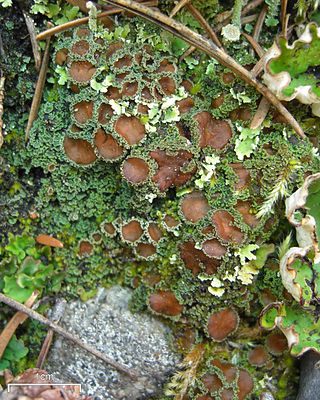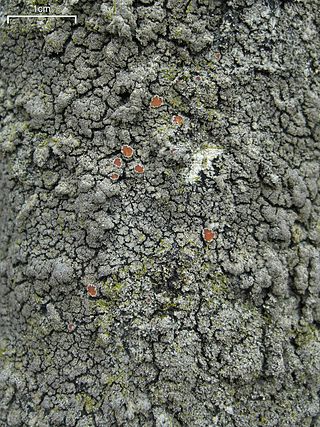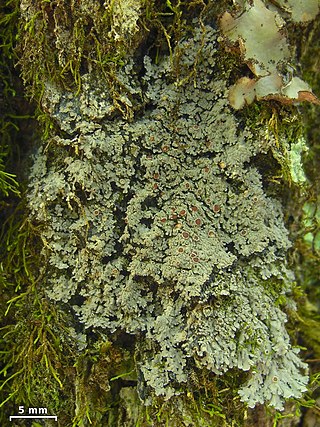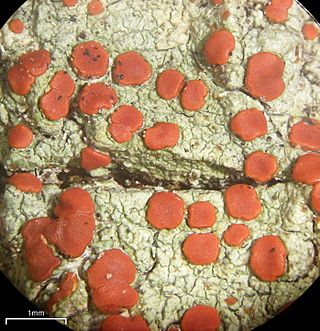
The Pannariaceae are a family of lichens in the order Peltigerales. Species from this family have a widespread distribution, but are especially prevalent in southern temperate regions.

Psoroma is a genus of lichen-forming fungi in the family Pannariaceae. The widespread genus contains about 30 species, most of which are found in south temperate regions.

Parmeliella is a genus of lichenized fungi in the family Pannariaceae. It occurs mainly in the tropics and sub-tropics, with species found in Africa, Asia, Australasia and South America. A recent (2020) estimate places 41 species in the genus.

Fuscopannaria is a genus of lichen-forming fungi in the family Pannariaceae. It has 55 species.
Fuscoderma is a genus of lichenized fungi in the family Pannariaceae. It was originally circumscribed as a subgenus of the genus Leioderma by David Galloway and Per Magnus Jørgensen in 1987. The same authors promoted it to generic status a couple of years later in 1989. The New Guinean species F. papuanum was added to the genus in 2002.

Ramboldia is a genus of lichen-forming fungi in the family Ramboldiaceae. The genus was circumscribed in 1994 by Gintaras Kantvilas and John Alan Elix. It was emended in 2008 by the inclusion of Pyrrhospora species containing the anthraquinone russulone in their apothecia and having a prosoplectenchymatous exciple. The family Ramboldiaceae was circumscribed in 2014 to contain the genus.

Protoparmelia is a genus of lichenized fungi in the family Parmeliaceae. The genus has a widespread distribution, and contains 11 species. Protoparmelia was circumscribed by French lichenologist Maurice Choisy in 1929.
Megalaria is a genus of lichen-forming fungi in the family Ramalinaceae. The genus was circumscribed by Austrian lichenologist Josef Hafellner in 1984, with Megalaria grossa assigned as the type species.
Pannaria phyllidiata is a species of lichen in the family Pannariaceae. Known from Australia, it was described as new to science in 2011. It is characterised by its unique phyllidia and distinct distribution.
Gibbosporina is a genus of 13 species of foliose lichens in the family Pannariaceae. It contains species that molecular phylogenetic analysis clustered together in a clade previously referred to as the "Physma"-group. Despite their morphological differences, this group shares several uniting characteristics. They have ring-like excipular margins around the thallus; strongly amyloid internal ascus structures; well-developed perispores that feature irregular gibbae, but not verrucae ; lacks secondary compounds than can be detected by thin-layer chromatography; and have tropical distributions.
Gibbosporina acuminata is a species of foliose lichen in the family Pannariaceae. It was described as a new species in 2016 by Norwegian lichenologist Arve Elvebakk. The specific epithet, derived from the Latin acumen, refers to the spiked bumps (gibbae) on the spore covering. It occurs in the tropical forests of Queensland, Australia, and the Philippines.
Gibbosporina elixii is a species of foliose lichen in the family Pannariaceae. It is endemic to Queensland, Australia. The lichen was described as a new species in 2016 by Arve Elvebakk, Soon Gyu Hong, and Per Magnus Jørgensen. The specific epithet honours Australian lichenologist John Alan Elix. He collected the type from Mossman Gorge National Park, where he found it growing on the base of a tree in a tropical rainforest along Mossman River. It has also been found in the Cardwell Range.
Gibbosporina leptospora is a species of foliose lichen in the family Pannariaceae. It was described as a new species in 2016 by Norwegian lichenologist Arve Elvebakk. The specific epithet leptospora, which combines the Greek lepto ("thin") with spore, refers to the thin perispore. The lichen occurs in northeast Australia, Papua New Guinea, Fiji, and New Caledonia.
Gibbosporina nitida is a species of foliose lichen in the family Pannariaceae. It was described as a new species in 2016 by Arve Elvebakk, Soon Gyu Hong, and Per Magnus Jørgensen. The specific epithet nitida, derived from the Latin nitidus ("glossy"), refers to the lustrous upper lobe surfaces. The lichen occurs in northeast Australia, Papua New Guinea, the Philippines, and Fiji.
Gibbosporina sphaerospora is a species of foliose lichen in the family Pannariaceae. It was described as a new species in 2016 by Arve Elvebakk and Soon Gyu Hong. The type was collected from Millaa Millaa Falls in Queensland, Australia, where it was found growing on fallen branches in a remnant rainforest near the falls. The specific epithet sphaerospora, which combines the Greek sphaero ("globose") with spora, refers to the spherical shape of the spores. The lichen occurs in Australia, Fiji, and Papua New Guinea.
Gibbosporina thamnophora is a species of foliose lichen in the family Pannariaceae. It was described as a new species in 2016 by Arve Elvebakk and Per Magnus Jørgensen. The type was collected from Eungella National Park in Queensland, Australia, where it was found growing on bark in a tropical rainforest near Broken River. The specific epithet thamnophora combines the Greek thamnos ("shrub") and -phora ("carrier"), and refers to the finely branched, shrubby cephalodia that are "carried" by the chlorobiont. The lichen occurs in Australia and Papua New Guinea.
Arve Elvebakk is a Norwegian mycologist and professor working from the Arctic University of Norway in Tromsø. He has published widely on Arctic biology, and climatology. Additionally, he collaborates with many mycologists across the world, and has published names for lichens in Australia, New Zealand, the South Pacific, and South America, and the Antarctic.
Pannaria aotearoana is a species of lichen in the family Pannariaceae, first described in 2016 by Arve Elvebakk and John Elix from a specimen found on a Coprosma linariifolia in the South Island of New Zealand.
Pannaria minutiphylla is a species of lichen in the family Pannariaceae, described as a new species in 2013 by Arve Elvebakk. The species is similar to Pannaria phyllidiata, but can be distinguished by its smaller phyllidia and ascospores that are elongated to ellipsoid.






